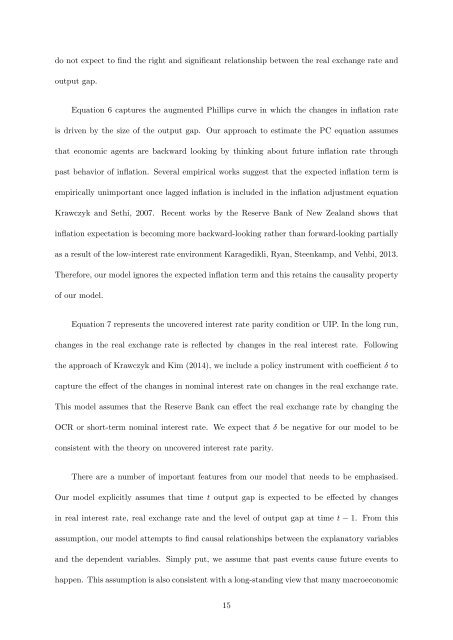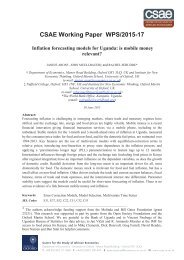Create successful ePaper yourself
Turn your PDF publications into a flip-book with our unique Google optimized e-Paper software.
do not expect to find the right and significant relationship between the real exchange rate and<br />
output gap.<br />
Equation 6 captures the augmented Phillips curve in which the changes in inflation rate<br />
is driven by the size of the output gap. Our approach to estimate the PC equation assumes<br />
that economic agents are backward looking by thinking about future inflation rate through<br />
past behavior of inflation. Several empirical works suggest that the expected inflation term is<br />
empirically unimportant once lagged inflation is included in the inflation adjustment equation<br />
Krawczyk and Sethi, 2007.<br />
Recent works by the Reserve Bank of New Zealand shows that<br />
inflation expectation is becoming more backward-looking rather than forward-looking partially<br />
as a result of the low-interest rate environment Karagedikli, Ryan, Steenkamp, and Vehbi, 2013.<br />
Therefore, our model ignores the expected inflation term and this retains the causality property<br />
of our model.<br />
Equation 7 represents the uncovered interest rate parity condition or UIP. In the long run,<br />
changes in the real exchange rate is reflected by changes in the real interest rate. Following<br />
the approach of Krawczyk and Kim (2014), we include a policy instrument with coefficient δ to<br />
capture the effect of the changes in nominal interest rate on changes in the real exchange rate.<br />
This model assumes that the Reserve Bank can effect the real exchange rate by changing the<br />
OCR or short-term nominal interest rate. We expect that δ be negative for our model to be<br />
consistent with the theory on uncovered interest rate parity.<br />
There are a number of important features from our model that needs to be emphasised.<br />
Our model explicitly assumes that time t output gap is expected to be effected by changes<br />
in real interest rate, real exchange rate and the level of output gap at time t − 1. From this<br />
assumption, our model attempts to find causal relationships between the explanatory variables<br />
and the dependent variables. Simply put, we assume that past events cause future events to<br />
happen. This assumption is also consistent with a long-standing view that many macroeconomic<br />
15





